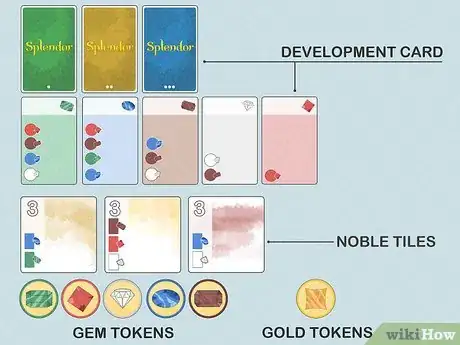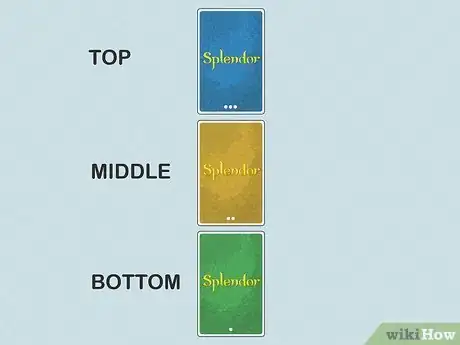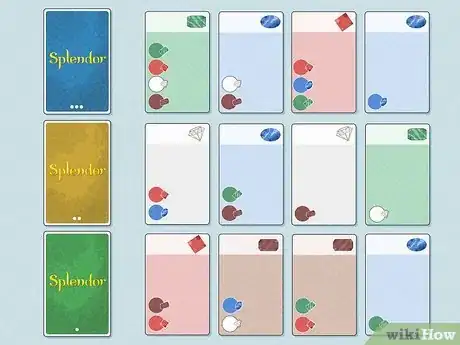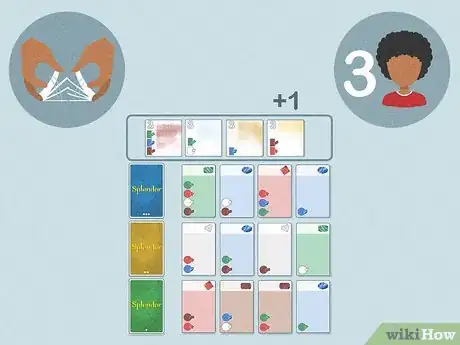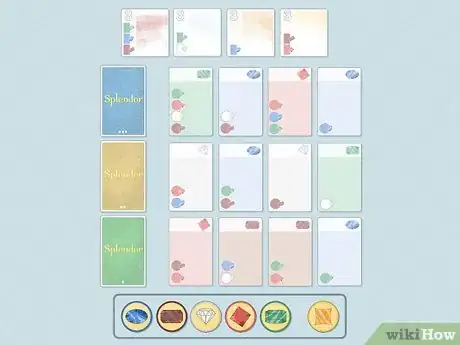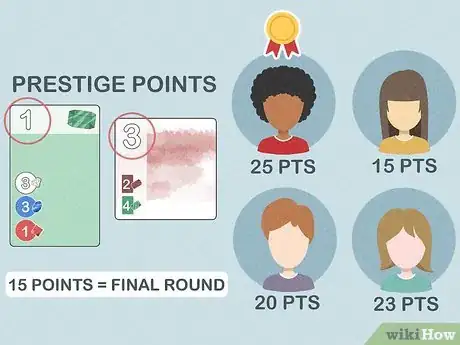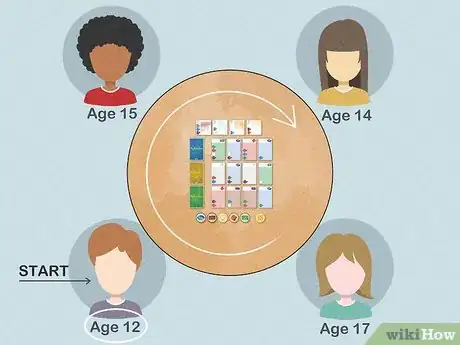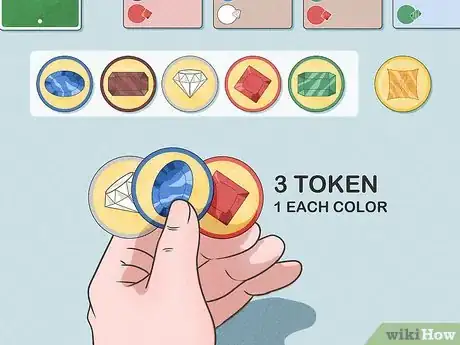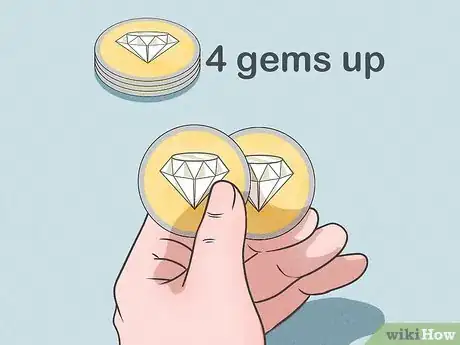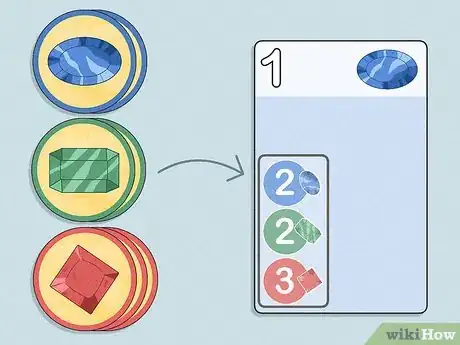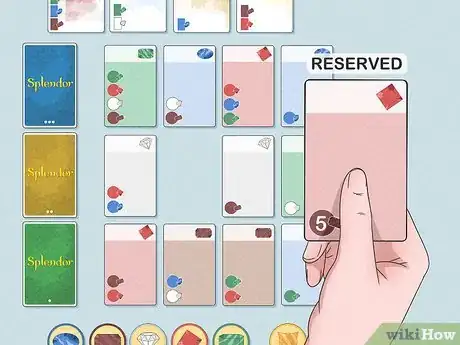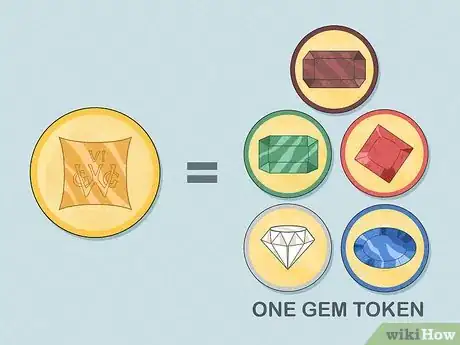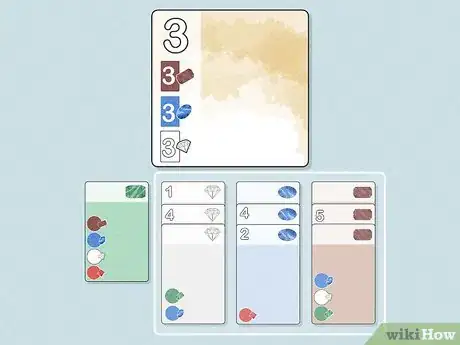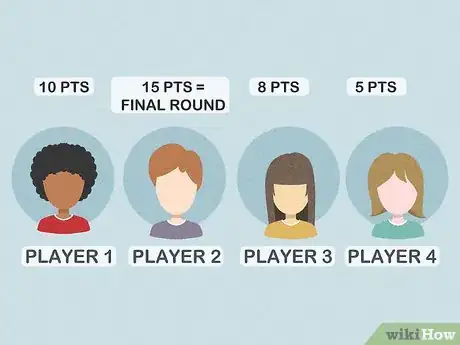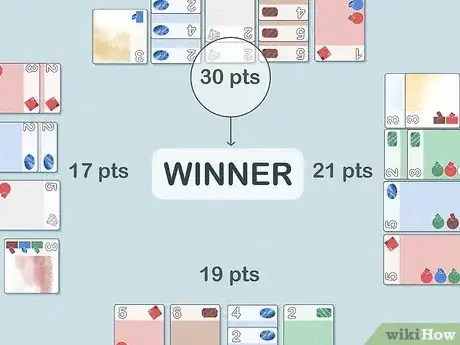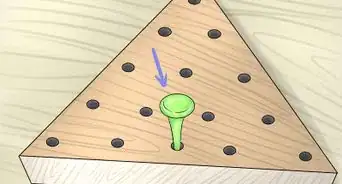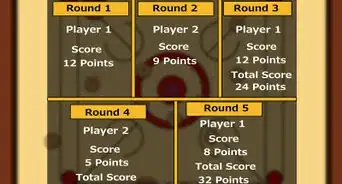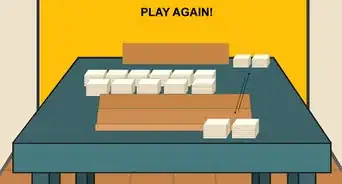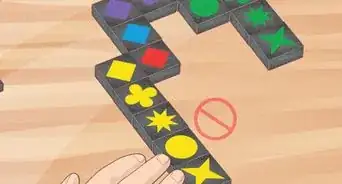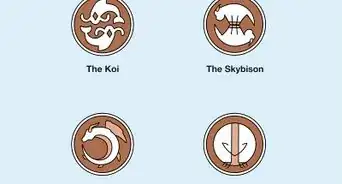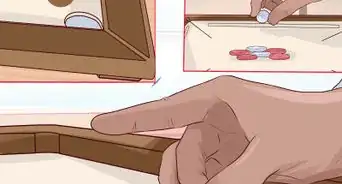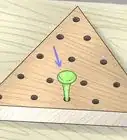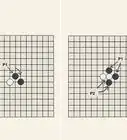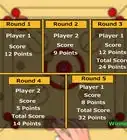This article was co-authored by wikiHow staff writer, Hannah Madden. Hannah Madden is a writer, editor, and artist currently living in Portland, Oregon. In 2018, she graduated from Portland State University with a B.S. in Environmental Studies. Hannah enjoys writing articles about conservation, sustainability, and eco-friendly products. When she isn’t writing, you can find Hannah working on hand embroidery projects and listening to music.
There are 9 references cited in this article, which can be found at the bottom of the page.
This article has been viewed 33,267 times.
Learn more...
If you’re looking for an immersive card game with gems, gold, and Nobles, look no further than Splendor. This game only requires 2 to 4 players and about 45 minutes of your time for one round. Set up your cards, grab your tokens, and collect those points!
Steps
Setting Up
-
1Open up your pack of cards and tokens. The game comes with development cards, Noble Tiles, gem tokens, and gold tokens. The development cards come in 3 colors (green, yellow, and blue), and they’ll be the main deck you’re pulling from. You can separate the Noble Tiles and the gem tokens and put them in their own piles.[1]
- The aim of the game is to get as many Prestige points as possible. You get Prestige points by purchasing development cards with your gem tokens. Whoever has the most Prestige points at the end of the game wins!
-
2Divide the cards by color and arrange them in decks. The development cards come in green, yellow, and blue. Shuffle each color, then put green on the bottom, yellow in the middle, and blue on top.[2]
- You can also look at the dots on the bottom of each card. Green has 1 dot, yellow has 2 dots, and blue has 3 dots.
Advertisement -
3Deal 4 cards from each deck, leaving them face-up in rows. Make a grid pattern with your cards to set up the game. Leave all 4 cards face-up so every player can see each development card.[3]
- Make sure everyone can see all of the cards!
-
4Shuffle and deal the Noble Tiles. Count up the amount of players you have, then add 1 extra tile. Put your Noble Tiles above your development cards in a line to arrange the Nobles.[4]
- If you have any extra Noble Tiles, just put them back in the box.
-
5Sort each token by color and put them at the bottom of the table. For 4 players, use all of the tokens. For 3 players, use 5 of each gem type but all of the gold tokens. For 2 players, use 4 of each gem type but all of the gold tokens.[5]
- Put the gold tokens on the very end of the row of gems to separate them.
Taking Actions
-
1Win the game by getting the most Prestige points. You can earn Prestige points by buying development cards and getting the attention of Nobles. The first person to get 15 Prestige points triggers the final round, but the person who has the most Prestige points at the end of the final round wins the game.[6]
- Have every player keep track of their Prestige points on their own.
-
2Start with the youngest player and go clockwise around the table. Figure out how old everyone is to start the game. Continue taking turns clockwise around the table as you play.[7]
-
3Choose from 4 different actions during your turn. When you first start the game, focus on taking gems to build up your stash. As you continue, you can work on buying development cards and getting Noble Tiles.[8]
-
4Take 3 different colored gems when you first start the game. You need gem tokens to purchase development cards, so it’s a good idea to build up your gem pile when you first start the game. Pick out 3 different colored gems and place them in front of you.[9]
- If the gem tokens are running low, you can use this action to grab 2 different gems instead of 3.
-
5Take 2 gems of the same kind if there are more than 4 in the stack. If you really need a certain type of gem, you can use an action to stockpile on 1 particular kind. However, if there are less than 4 gems in the stack, you can’t do this action.[10]
- This action gets you less tokens than taking 3 different ones, so it’s a little bit of a desperate move. Try saving it for the end of the game when you really need to focus on buying cards and getting Noble Tiles.
-
6Purchase a development card using your tokens. Every development card has a price on the top right corner, and you can use your gem tokens to buy it. Replace the card with a card from the stack on the left and pay by discarding the required tokens.[11]
- Development cards give you Prestige points, so it’s important to stock up.
- You don’t get any new tokens with this option.
-
7Reserve a development card if you can’t buy it yet. If there’s a development card that you really want but you can’t quite afford it yet, you can pick the card up and keep it in your hand instead of placing it in front of you. Once you have enough gems to buy the development card, you can use an action on your turn to purchase it and place it down in front of you.[12]
- You can only reserve 3 development cards at a time.
Continuing Your Turn
-
1Trade in gold tokens for any gems you need. Gold tokens are wild, which means you can trade them in and replace them with any gem token you’d like. You can do this at the beginning of your turn to build up gems and buy the cards you want.[13]
- One gold token = one gem token.
-
2Collect a Noble card if you’ve gotten their attention. Every Noble card has a combination of development cards that they’re interested in. Before you end your turn, take a look at each card to see if you have the combination to grab someone’s attention. If you do have enough development cards for a Noble, collect that card and put it in front of you.[14]
- You can only use your development cards to attract attention, not any gem tokens.
- You can only take 1 Noble card per turn, even if you attract the attention of multiple Nobles.
-
3Discard tokens if you have more than 10. At the end of your turn, count up how many tokens you have in front of you. If you have more than 10, pick some to put back into the gem pile before you move on.[15]
- Remember, gold counts as a token too!
-
4Begin the final round when someone reaches 15 Prestige points. If you get 15 Prestige points, let all the other players know. Let everyone who hasn’t had a turn that round take their turn before ending the game.[16]
- This gives the other players a chance to get as many Prestige points as they can before the game ends.
-
5Tally up your Prestige points to find out who wins. After everyone has taken their turn in the final round, count up your Prestige points from all your development cards and Noble Tiles. Crown the winner when you figure out who has the most points![17]
- Even if you got 15 Prestige points to start the final round, there’s no guarantee that you’ll be the winner. Other people may have gotten more points than you during the final round.
- If there’s a tie, the person who has purchased the least amount of development cards wins.
References
- ↑ https://www.boardgamehalv.com/how-to-play-splendor-board-game/
- ↑ https://www.ultraboardgames.com/splendor/game-rules.php
- ↑ https://www.youtube.com/watch?t=51&v=rue8-jvbc9I&feature=youtu.be
- ↑ https://www.ultraboardgames.com/splendor/game-rules.php
- ↑ https://www.boardgamehalv.com/how-to-play-splendor-board-game/
- ↑ https://www.youtube.com/watch?t=15&v=2A0CQ0xsrv0&feature=youtu.be
- ↑ https://www.ultraboardgames.com/splendor/game-rules.php
- ↑ https://www.youtube.com/watch?t=134&v=rue8-jvbc9I&feature=youtu.be
- ↑ https://www.boardgamehalv.com/how-to-play-splendor-board-game/
- ↑ https://www.boardgamehalv.com/how-to-play-splendor-board-game/
- ↑ https://gamenightbros.com/splendor/
- ↑ https://gamenightbros.com/splendor/
- ↑ https://www.youtube.com/watch?t=402&v=rue8-jvbc9I&feature=youtu.be
- ↑ https://www.youtube.com/watch?t=428&v=rue8-jvbc9I&feature=youtu.be
- ↑ https://www.youtube.com/watch?t=75&v=2A0CQ0xsrv0&feature=youtu.be
- ↑ https://gamenightbros.com/splendor/
- ↑ https://www.ultraboardgames.com/splendor/game-rules.php
About This Article
Splendor is a 2-4 player board game where players try to accumulate wealth and purchase developments to attract nobles and gain prestige as a Renaissance-era merchant. To set the game up, separate the development cards by color and shuffle them into separate piles. Arrange them in a column so that all of the level 1 green cards are on the bottom, the level 2 yellow cards are in the middle, and the level 3 blue cards are at the top. Flip over the top 4 cards from each pile and lay them face-up in rows on the right side of the deck that they belong to. Next, shuffle the noble cards and flip over one card for each player in the game, plus one extra. Set these in a row on top of the development cards. Finally, separate the gemstone tokens by color and set them up in separate piles under the development cards. Play starts with the youngest player at the table and moves clockwise. On a player’s turn they can do 1 of 4 things. First, they may take 3 gem tokens in different colors. Alternatively, they can take 2 gem tokens of the same color, although there must be at least 4 tokens of that color available in the pile in order to do this. Gold does not count as a gem. Players may never have more than 10 gem tokens in front of them at any one time, and a player must put any excess tokens back at the end of their turn if they have too many of them. If a player has enough gems, they can also spend their turn buying a development card. The price of each development is listed on the front of the card, and they pay the gems for it by returning them to the pile. When a player buys a development card, they take it off of the board and put it in front of them, face-up. This development is theirs for the rest of the game. That card is replaced with another from its corresponding draw pile. On the top right of each development card is a gemstone. When a development is face-up in front of a player, they can treat the gemstone on that card like it’s a gem token in their hand, and they have access to this extra resource for the rest of the game. On the top left of some cards, there is a number. These are prestige points, and the aim of the game is to get as many prestige points as possible. The final thing a player can do on their turn is reserve a development. To do this, they take the development card off of the board without paying for it and replace it with a card from the draw pile. However, instead of this card going face-up, it goes into the player's hand. When a player reserves a development, they take a gold token. Gold tokens are basically wild cards, and players can use them in place of any gemstone. Players can only have 3 development cards in their hand at a time, and while they don’t get access to the prestige points or gemstone on the card while it’s in their hand, they can buy it on their turn by paying its cost to add it to their board. At the end of each player’s turn, everyone checks to see if they’ve attracted the attention of one of the noblemen or noblewomen by looking at the noble cards at the top of the board. The developments that attract each noble are printed on their card underneath their prestige points. If a player attracts them, they are automatically added to their board. The nobles are not replaced once they’re taken from the board. The game continues until any player reaches 15 prestige points, which triggers the final round in the game. Once every player takes one more turn, everyone adds up their prestige points and the player with the highest prestige is the winner.
